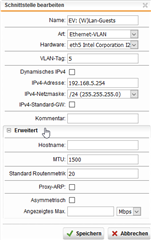Hallo Zusammen,
ich habe ein paar Konfigurationsschwierigkeiten, hoffe das mir jemand unter die Arme greifen kann?
Folgende Ethernet-VLANs sind vorhanden:
Netzwerk 1: 192.168.5.0/24; VLAN 5; ETH5 (Gäste)
Netzwerk 2: 192.168.6.0/24; VLAN 6; ETH6 (Intern)
Netzwerk 3: 192.168.7.0/24; VLAN 7; ETH7 (vom Switch untagged in Richtung APs)
Ich möchte nun 2 WLAN Netzwerke über eine Gruppe (2 Stk.) 55C APs bereitstellen. Die WLAN-Netzwerke sollen die vorhandenen Ethernet-VLAN-Netzwerke 1 und 2 benutzen. Also kabelgebunden wie auch drahtlos wäre dann jeweils nur ein Netzwerk zu verwalten.
Welche Konfigurationsschritte muss ich dazu auf meiner UTM 9 vornehmen um das zuvor beschriebene Szenario zu erhalten?
Danke und viele Grüße
Maik
This thread was automatically locked due to age.





